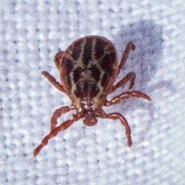
Dog owners in the UK are being warned about an outbreak of an animal disease that is carried by ticks.
It is the first time that experts have established an outbreak of babesiosis in the country.
In Essex, two dogs have died and three others needed blood transfusions after contracting the disease.
Experts say that it will be impossible to stop the spread of the disease, which is caused by a single-celled parasite.
The ticks carrying the Babesia canis parasite have been found in fields in Harlow, Essex. The local council has put up a sign with a map defining the area and advising dog walkers not to enter.
Two government agencies are now investigating the outbreak: the Animal and Plant Health Agency and Public Health England.
Read live updates on this story
Clive Swainsbury is a vet at the Forest Veterinary Centre in Harlow. He has been treating some of infected dogs, including the one that died.
“The parasite enters the bloodstream, enters the cells, and in the process of trying to kill the parasite the dog will actually destroy its own blood cells. So they become very anaemic.”
The expectation is that it will spread throughout the country.
Easy to miss
“At present we have a very well defined area. The problem in the future is that every female tick will lay a couple of thousand eggs and all those offspring from that disease will also carry the disease.
“As mammals move around they will start spreading the disease. Although you can advise dog walkers not to go there, it’s possible that foxes and other animals will transport these ticks.”
The symptoms of babesiosis within dogs include weakness, lethargy, pale gums, red urine and fever. A serious problem is that Babesia can be mistaken for other less dangerous diseases.
“It’s easy to miss it. And because it’s a new disease to this country, we as a profession aren’t used to looking for this disease on a regular basis.”
TickImage copyrightOther
The tick acts as a vector. In the same way that a mosquito transmits malaria by sucking the blood from a person, the tick does the same to an animal. It also sucks blood and in the process of feeding the disease will transmit from the tick to the dog. It’s not contagious between dogs themselves.
The Pet Food Manufacturer’s Association estimates that there are more than nine million dogs in the UK – almost a quarter of households.
It’s dogs that spend a lot of time outdoors, especially in rough and wooded areas, that are most at risk.
Tip of the iceberg?
“The only solution is to kill the ticks quickly,” says Mr Swainsbury. “Some of the tick products available will kill the tick quick enough to prevent the tick spreading the disease to the dog, because the tick needs to be feeding for 24 hours at least before it transmits the disease.
“But not all tick products do that and you need to seek advice from your vet.”
The tick found in the UK carrying the Babesia canis strain is called Dermacentor reticulatus.
Prof Richard Wall is professor of zoology at the University of Bristol. He is helping to conduct the largest every veterinary study of ticks and tick-borne diseases, called the Big Tick Project.
“People who work on ticks and tick-borne diseases are concerned about this outbreak. It could be the tip of the iceberg. If it spreads quickly throughout the UK then it is going to be a very significant problem, but we don’t have enough info at this stage to make a prediction about how quickly this will happen.
“It’s highly unlikely that the problem will now disappear, we have the vectors, we have the pathogens established in the UK.”
TV naturalist Chris Packham says: “The population of ticks is getting bigger year on, year on. That’s because there is better over winter survival of the adults – it’s warm and mild through our winters and that means they can breed more quickly in the spring and there are a lot more of them.
“These animals are very good at what they do, and they need to find hosts to suck its blood to reproduce, and they do it brilliantly. So if you walk in an area where there are ticks, with a dog, they will get on to your dog.”
There are several species of Babesia and some of them affect humans. In parts of the world including the United States, human babesiosis is transmitted by the same tick that carries Lyme Disease, caused by Borrelia bacteria.
“The first thing that dog owners can do to protect their animals is to be aware of the problem. Your dog could become very seriously ill or die, and if you get Lyme disease then the same could be the case for you.”